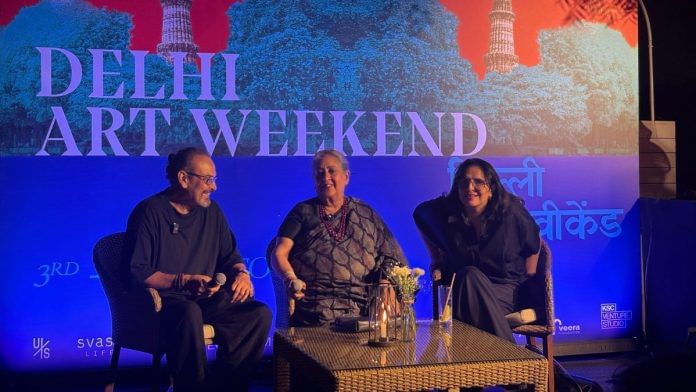New Delhi: In the early 1990s, as India opened its economy and creative energy surged, Bharti Kher arrived from the UK in Delhi expecting an artistic renaissance. She imagined a country filled with museums, art centers, and bold new ideas. Over three decades later, that vision remains unfulfilled — not for lack of talent, but because culture was never made a priority.
At the Delhi Art Weekend, held at Olive Bar & Kitchen in Mehrauli on 3 October, artists Bharti Kher and Subodh Gupta joined writer and editor Malvika Singh on a panel titled Responsibility Response: Making Art in the Present.
The discussion explored what it means to create art in turbulent times, and the role of the artist in society. The conversation took place in a small, lively gathering of young artists, collectors, and art lovers.
“India was brimming with energy when I arrived in 1992. We envisioned a future where art centres would emerge across cities and small towns alike, places where people could engage with contemporary work. There was a real sense that something extraordinary was about to unfold. But it didn’t. And the reason is simple: successive governments have consistently failed to place any real value on culture,” said Kher.
Museums, public spaces, and government apathy
Kher said that many artists had a vision at the time, of a country where contemporary art centres would mushroom across towns and cities, modelled on the “constellation” networks seen in Europe.
“When I arrived, Star TV arrived too. It was mad, exciting, and dynamic. Delhi was this brilliant intellectual hub. People were reading. People were debating. I thought India was like the UK in the 1960s. If you wanted to be a filmmaker, you said it and you were one. Same with art. It felt like anything was possible,”she said.
The reality, however, was different. Despite the explosion of talent, Kher said, art needed the support of the systems’ — from funding to public institutions — but that never followed.
“To become brilliant, to become great, you have to listen. And the tragedy of India is that people in power stop listening once they get there. It’s me or no one,” Kher said.
Subodh Gupta said people in India often know art through celebrity and price tags, not through engagement or understanding. That’s a failure of the system, not the audience.
But the new Bihar Museum in Patna stands out as a rare beacon of hope. Designed by Pritzker Prize-winning architect Fumihiko Maki and Mumbai-based firm Opolis Architects, it draws thousands with daily interactive spaces and thoughtful programming.
Malvika Singh highlighted that museum culture is not foreign to India, many villages, especially in Nagaland, preserve their heritage through small home museums showcasing tribal artefacts, clothing, and ceremonial items. “These spaces create pride and continuity,” she said. “Scaling this model nationally could help bridge the cultural disconnect.”
As India advances economically, the need to build and cherish cultural institutions becomes urgent. Without spaces where art can live, breathe, and challenge, the country risks losing its creative soul.
“Art, culture, theatre, sports are not soft power, they are fundamental power. You can build roads and infrastructure, but if you don’t build memory and imagination, what are you really building?” said Kher.
Also read: Meghnad Desai’s last book brings Gandhi and Jinnah in one frame. ‘It’s the story of India’
Embracing materials, memories
Kher’s journey from a painter in the UK to a sculptor in India is accompanied by a deep connection to materials and memory. She had always admired classical European sculptures. But having struggled to sculpt draped fabric in marbles, she found her strength in Indian saree.
As her practice evolved, she became more fascinated by the saree. The women she met, the collectors she befriended, and her own mother’s wardrobe offered a scope for her artistic imagination.
“The sari carries its own history, its own language. They talk about anthropology, they talk about memory, they talk about love, care, femininity, the female body, the smell of the body,” she said. “Like when your mom leaves, you kind of smell the pillow. When your mother gives you a sari, you can smell her in the sari that she was wearing. The perfume that she wears doesn’t smell the same on you, or on your sister, it just smells like your mother.”
That sensory memory became the spark for Kher’s new body of work. So, she collected objects and used them because they already had their own inherent histories tied to them.
Her work often returns to motifs: the bindi, the broken mirror, the body. “My work is primarily interested in the body. I’m a woman. I’m interested in female power, shakti. I believe all things have energy, and there’s a language I’ve created in the studio to explore that.”
The bindi, she argued, is “the sign of consciousness.” The broken mirror is the fragmentation of self, multiplicity. In her world, objects and materials talk and she invites audiences to listen.
Gupta, meanwhile, began with the everyday. His childhood in Bihar, his people, his language, and amateur theatre became his artistic voice. He looked inward and the inner gaze eventually led him to his own kitchen.
He brought all the utensils from the kitchen and put them in the drawing room.
“The light on my kitchen utensils made me see them differently,” Gupta said. “They started talking to me, becoming something more than just things.”
This later defined his signature practice — using everyday Indian objects, especially utensils, in large-scale installations.
Both artists share a belief that art is for everyone. They challenge the notion that appreciation requires special training or elitism.
“People have an innate ability to look at art. They may not always like what they see, but they look. And that’s the beginning,” Kher said.
(Edited by Aamaan Alam Khan)






